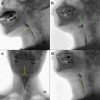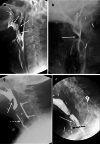An update on pharyngeal assessment by the modified barium swallow
- PMID: 39648178
- PMCID: PMC12069153
- DOI: 10.1007/s00261-024-04707-9
An update on pharyngeal assessment by the modified barium swallow
Abstract
The modified barium swallow study (MBSS) is a diagnostic examination that visualizes the functional anatomy and physiology of the oral pharyngeal swallowing mechanism in real time. The MBSS, a videofluoroscopic imaging method, is indicated for patients with known or suspected oropharyngeal dysphagia and ideally involves the combined expertise of a radiologist and speech pathologist. The MBSS provides critical diagnostic insights that help in identifying and assessing the type and severity of physiological swallowing impairments, evaluating the safety of oral intake, testing the effectiveness of evidence-based interventions, and developing treatment plans. This manuscript aims to present an overview of MBSS standards from an interdisciplinary perspective, emphasizes key areas of best practices, and reviews the common morphologic abnormalities seen on MBSS exams.
Keywords: Dysphagia; Modified barium swallow; Swallowing.
© 2024. The Author(s).
Conflict of interest statement
Declarations. Conflict of interest: The authors declare no competing interests.
Figures





Similar articles
-
Stakeholder Perspectives on Radiation Use and Interdisciplinary Collaboration in Adult Modified Barium Swallow Studies.Dysphagia. 2023 Feb;38(1):23-32. doi: 10.1007/s00455-022-10447-z. Epub 2022 Apr 24. Dysphagia. 2023. PMID: 35461361 Free PMC article. Review.
-
Role of the modified barium swallow in management of patients with dysphagia.Otolaryngol Head Neck Surg. 1997 Mar;116(3):335-8. doi: 10.1016/S0194-59989770269-9. Otolaryngol Head Neck Surg. 1997. PMID: 9121786
-
Inter-rater Agreement of Clinicians' Treatment Recommendations Based on Modified Barium Swallow Study Reports.Dysphagia. 2018 Dec;33(6):818-826. doi: 10.1007/s00455-018-9907-6. Epub 2018 Jun 7. Dysphagia. 2018. PMID: 29882104
-
Best Practices in Modified Barium Swallow Studies.Am J Speech Lang Pathol. 2020 Jul 10;29(2S):1078-1093. doi: 10.1044/2020_AJSLP-19-00189. Epub 2020 Jul 10. Am J Speech Lang Pathol. 2020. PMID: 32650657 Free PMC article. Review.
-
Effect of a standardized fluoroscopic procedural approach on fluoroscopy time during infant modified barium swallow studies.Int J Pediatr Otorhinolaryngol. 2020 Nov;138:110396. doi: 10.1016/j.ijporl.2020.110396. Epub 2020 Sep 28. Int J Pediatr Otorhinolaryngol. 2020. PMID: 33152985
Cited by
-
Esophageal and Oropharyngeal Dysphagia: Clinical Recommendations From the United European Gastroenterology and European Society for Neurogastroenterology and Motility.United European Gastroenterol J. 2025 Jul;13(6):855-901. doi: 10.1002/ueg2.70062. Epub 2025 Jun 21. United European Gastroenterol J. 2025. PMID: 40543044 Free PMC article.
References
-
- Martin-Harris B, Logemann JA, McMahon S, Schleicher M, Sandidge J (2000) Clinical utility of the modified barium swallow. Dysphagia;15(3):136-41. 10.1007/s004550010015. - PubMed
-
- Martin-Harris B, Canon CL, Bonilha HS, Murray J, Davidson K, Lefton-Greif MA (2020) Best practices in modified barium swallow studies. Am J Speech Lang Pathol;29(2S):1078–93. https://www.ncbi.nlm.nih.gov/pubmed/32650657. - PMC - PubMed
-
- Martin-Harris B, Bonilha Heather S, Brodsky Martin B, Francis David O, Fynes Margaret M, Martino R, et al. (2021) The modified barium swallow study for oropharyngeal dysphagia: Recommendations from an interdisciplinary expert panel. Perspectives of the ASHA Special Interest Groups;6(3):610-9. 10.1044/2021_PERSP-20-00303.
-
- Zarzour J, Martin-Harris B, Hill J (2024) Ce information: Modified barium swallow study acr-spr practice parameter: 2023 update. Applied Radiology;53(2).
-
- Association AS-L-H (2024) Adult dysphagia: Overview. https://www.asha.org/Practice-Portal/Clinical-Topics/Adult-Dysphagia/.
Publication types
MeSH terms
Substances
LinkOut - more resources
Full Text Sources
Medical

